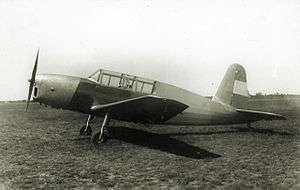I.Ae.32 Chingolo
| I.Ae.32 Chingolo | |
|---|---|
 | |
| Role | Advanced trainer |
| National origin | Argentina |
| Manufacturer | Instituto Aerotécnico |
| Designer | Ernesto Vicente |
| First flight | 1949 |
| Number built | 1 |
The I.Ae.32 Chingolo (named after the South American bird) was a civil trainer, touring and aerobatic aircraft developed in Argentina in the 1940s. It was designed by Ernesto Vicente and developed by the Instituto Aerotécnico for manufacture by the company “Mario Vicente Construcciones Aeronáuticas” in Córdoba Province as an initiative under President Juan Perón's first five year plan.
Design and development
The design, which shared some of the technical characteristics of the earlier I.Ae. 31 Colibrí, was a conventional low-wing cantilever monoplane with and had fixed tailwheel undercarriage; seating a student pilot (or passenger) and instructor (or pilot) in a tandem enclosed cockpit. Only one prototype was built.
Specifications
General characteristics
- Crew: two, student pilot and instructor
- Length: 8,12 m ( ft in)
- Wingspan: 10,70 m ( ft in)
- Height: 2.10 m ( ft in)
- Wing area: 16.50 m2 ( ft2)
- Empty weight: 750 kg ( lb)
- Gross weight: 981 kg ( lb)
- Powerplant: 1 × Blackburn Cirrus Major 3, 115 kW (155 hp)
Performance
- Maximum speed: 230 km/h (143 mph)
- Endurance: 1 hours 50 min
- Service ceiling: 5,180 m ( ft)
See also
References
- Taylor, Michael J. H. (1989). Jane's Encyclopedia of Aviation. London: Studio Editions. p. 524.
- Bridgeman, Leonard. Jane's All The World's Aircraft 1950-1951 edition New York: The Mcgraw.Hill Book Company, Inc, 1950 Pg.9c (No ISBN)
Further reading
- Burzaco, Ricardo (1995). Las Alas de Perón, Aeronáutica Argentina 1945/1960 (in Spanish) (1st ed.). Buenos Aires: Editorial Da Vinci. ISBN 978-987-96764-4-8.
External links
| Wikimedia Commons has media related to FMA I.Ae. 32 Chingolo. |
This article is issued from
Wikipedia.
The text is licensed under Creative Commons - Attribution - Sharealike.
Additional terms may apply for the media files.